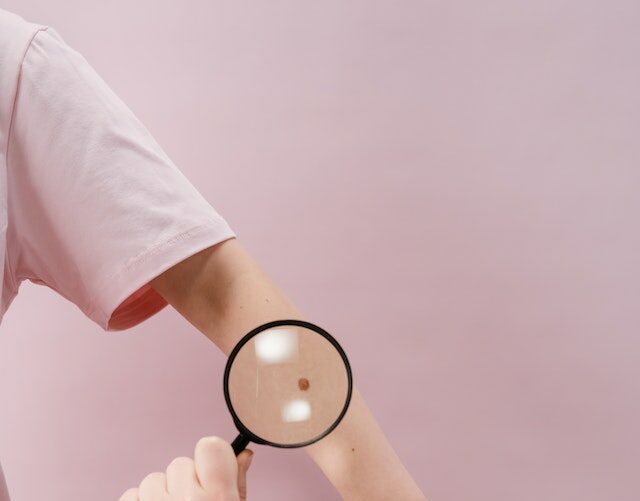Birthmarks and moles are two distinct types of skin marks with different causes. Birthmarks usually appear at or shortly after birth and can be several colors but often have a reddish hue. Moles, on the other hand, are typically brown in colour and present themselves later in life due to sun exposure or genetics. Despite the differences between them, both moles and birthmarks should be checked by a doctor if they seem to change shape or size so that any potential problems can be identified quickly.
What is a birthmark?
(Photo by Maksym Zakharyak on Unsplash )

Most people have heard of birthmarks, but many don’t know exactly what they are. A birthmark is a congenital, benign nevus (mole) that is present at birth or develops soon after birth. Birthmarks can occur anywhere on the body and come in a variety of shapes, sizes, and colours. Some common types of birthmarks include:
What is a mole?
(Photo by cottonbro studio on Pexles.com)

Moles are usually brown or black growths on the skin that occur when pigment-producing cells (melanocytes) grow in clusters. They can occur anywhere on the body, but most commonly appear on areas exposed to the sun, such as the face, neck, hands, and arms. Moles can be flat or raised, and some may change in appearance or grow larger over time. Most moles are benign (noncancerous), but it’s important to have them checked by a doctor if you notice any changes.
Birthmarks vs. Moles: How to Tell the Difference
There are a few key things to look for when trying to distinguish a birthmark from a mole. First, birthmarks are usually larger than moles, and they tend to be more evenly colored. Moles, on the other hand, are usually smaller and can be more irregular in shape and color. Additionally, moles will usually have a smooth surface, while birthmarks may be raised or bumpy. Finally, moles typically appear later in life, while birthmarks are present at birth or develop soon after.
If you’re still unsure whether a spot on your skin is a birthmark or mole, it’s best to consult with a doctor or dermatologist. They can take a closer look and provide a definitive answer.
When to See a Doctor about a Birthmark or Mole
If you have a birthmark or mole that is changing in size, shape, color, or texture, it is important to see a doctor. Other signs that indicate you should see a doctor about a birthmark or mole include:
- If the birthmark or mole bleeds
- If the birthmark or mole is painful
- If the birthmark or mole is itchy
- If the birthmark or mole changes in appearance in any other way
- Asymmetry: If one half of the mole does not match the other half, it may be a sign of skin cancer.
- Border: Irregular or jagged borders can indicate a dangerous mole.
- Color: Moles that have multiple colors or have changed color can be a sign of skin cancer.
- Diameter: A mole that is larger than a pencil eraser (6mm) can be a sign of skin cancer.
- Evolution: If a mole has changed in size, shape, or color, it may be a sign of skin cancer.
Treatment Options for Dangerous Moles
If a mole is found to be dangerous, it will typically be removed for biopsy. If the biopsy results show that the mole is cancerous, further treatment may be necessary, such as Mohs surgery or other skin cancer treatments. Additionally, if you have a family history of melanoma (skin cancer) it is important to see a doctor about any new moles or changes in existing moles.
How do you know if it’s a birthmark?
One way is to look at the color of the mark. Birthmarks are usually red, brown, blue, or black. They can also be pale pink or white. Another way to tell if a mark is a birthmark is to look at its location on the body. Birthmarks tend to appear on the face, scalp, chest, back, or buttocks. Mole, on the other hand, are more likely to appear on the trunk, arms, legs, or back. Finally, you can ask your doctor for a professional opinion.
How do you know if it’s a mole?
Moles are usually uniform in color, while birthmarks can be many different colors. Moles are also generally round or oval shaped, while birthmarks can be any shape. Moles are usually found on the skin, while birthmarks can be found on any surface of the body. Finally, moles typically have a smooth texture, while birthmarks can be bumpy or raised.
What are the types of birthmarks?
There are two types of birthmarks: vascular and pigmented. Vascular birthmarks are made up of extra blood vessels in the skin. They can be pink, red, or purple, and they’re often found on the face, scalp, chest, or back. Pigmented birthmarks are made up of extra pigment in the skin. They can be brown or black, and they’re often found on the face, neck, or shoulders.
- Salmon patches (also called stork bites or angel kisses): these are small, flat red or pink marks that often appear on the forehead, back of the neck, or eyelids;
- Port-wine stains: these are large, purple or reddish marks that occur most often on the face;
- Hemangiomas: these are bright red growths that can occur anywhere on the body;
- Mongolian spots: these are large blue or grey marks that commonly appear on the lower back and buttocks;
- Cafe au lait spots: these are light brown marks that can occur anywhere on the body;
- Macular stains: these are small yellow or white marks that commonly appear on the face.
What are the types of moles?
There are two main types of moles: Congenital moles and Acquired moles.
Congenital moles, also called birthmarks, are moles that are present at birth or develop in the first few weeks of life. They may be flat or raised, and can vary in color from pink to dark brown. Most congenital moles are benign (non-cancerous), but a small percentage can develop into melanoma later in life.
Acquired moles are moles that develop after birth, usually during adolescence or young adulthood. These moles tend to be smaller than congenital moles, and most are benign. However, acquired moles have a slightly higher risk of developing into melanoma than congenital moles.
Are babies born with moles or birthmarks?
Most babies are born with some kind of birthmark or mole. These are usually harmless and do not require treatment. Some moles can become cancerous, so it is important to have any suspicious moles checked by a doctor.
Can birthmarks appear later in life?
Yes, birthmarks can appear later in life. Birthmarks are usually benign (noncancerous) and do not require treatment. However, some birthmarks may be cancerous or at risk for becoming cancerous, so it is important to have any new or changing birthmarks checked by a doctor.
Is a birthmark a beauty mark?
A birthmark can be referred to as a beauty mark, but it is not always considered one. Beauty marks are often intentional cosmetic marks, while birthmarks are typically natural, accidental markings on the skin that can range in appearance from small freckles to large, dark patches. The designation of a birthmark as a beauty mark is subjective and depends on personal taste and cultural attitudes towards beauty and physical appearance.
What is the most common birthmark?
The most common type of birthmark is a pigmented birthmark, also known as a “café-au-lait” spot. These are flat, light-brown or dark-brown spots that are present at birth or develop soon after. They are typically harmless and are caused by an excess of melanin, the pigment that gives color to the skin, hair, and eyes. Another common type of birthmark is a vascular birthmark, such as a “strawberry” mark or a port-wine stain. These birthmarks occur when there is an abnormal growth of blood vessels in the skin, which can cause red, purple, or dark-red marks.
Can you remove a birthmark?
Yes, some birthmarks can be removed, but the method of removal depends on the type of birthmark and its location on the body. For example:
- Pigmented birthmarks: These can be lightened or removed using laser therapy, cryotherapy (freezing), or topical lightening agents.
- Vascular birthmarks: These can be treated using laser therapy, surgery, or other medical procedures.
Hemangiomas: These are benign (non-cancerous) tumors that are made up of extra blood vessels. They can be treated using laser therapy, steroid injections, or surgery, depending on the size and location of the hemangioma.
It’s important to note that some birthmarks cannot be completely removed and may require multiple treatments. The success of the removal also depends on the size, depth, and location of the birthmark, as well as the age of the individual and their overall health. It’s always best to consult with a dermatologist or plastic surgeon for an accurate assessment and to discuss the best treatment options for your particular case.
What birthmark says about you?
There is no scientific evidence to support the idea that birthmarks hold any significant meaning or indicate anything specific about a person’s character, personality, or future. Birthmarks are simply variations in the color or texture of the skin that can occur for a variety of reasons, including genetics, hormonal factors, and environmental factors.
The idea that birthmarks are connected to personality or character traits is a superstition that dates back many centuries, but has no basis in science. There is no scientific evidence to support the idea that birthmarks hold any meaningful information about a person. It’s important to focus on a person’s actions, personality, and character, rather than physical traits such as birthmarks, when evaluating someone’s worth or qualities.
Can birthmarks grow hair?
Yes, birthmarks can grow hair. In fact, many people have hairy birthmarks. The medical term for a hairy birthmark is “hirsutism.” Hirsutism can be present at birth or develop later in life. It can be a sign of a medical condition, such as polycystic ovarian syndrome (PCOS). PCOS is a hormonal disorder that can cause irregular periods, acne, and excess hair growth. Treatment for hirsutism depends on the underlying cause. If the cause is unknown or cannot be treated, various hair-removal methods may be used to improve appearance.
How do you stop moles from growing?
If you’re concerned about a mole on your body, there are a few things you can do to prevent it from growing. First, avoid excessive sun exposure. Moles are more likely to form if the skin is constantly exposed to sunlight. If you must be in the sun, wear protective clothing and use sunscreen with an SPF of 30 or higher. Secondly, don’t use tanning beds. The ultraviolet light from these devices can also cause moles to form. Finally, see a dermatologist if you notice any changes in an existing mole, such as an increase in size, change in color, or development of new symptoms like itching or bleeding.
Is it normal to get new moles?
Most people will develop new moles at some point in their lives. This is especially true for young people, as their bodies are still growing and changing. While the vast majority of these moles are benign, it’s important to keep an eye on them and have any new ones checked out by a doctor, just to be safe.
Featured Image By – Photo by Atikh Bana on Unsplash








